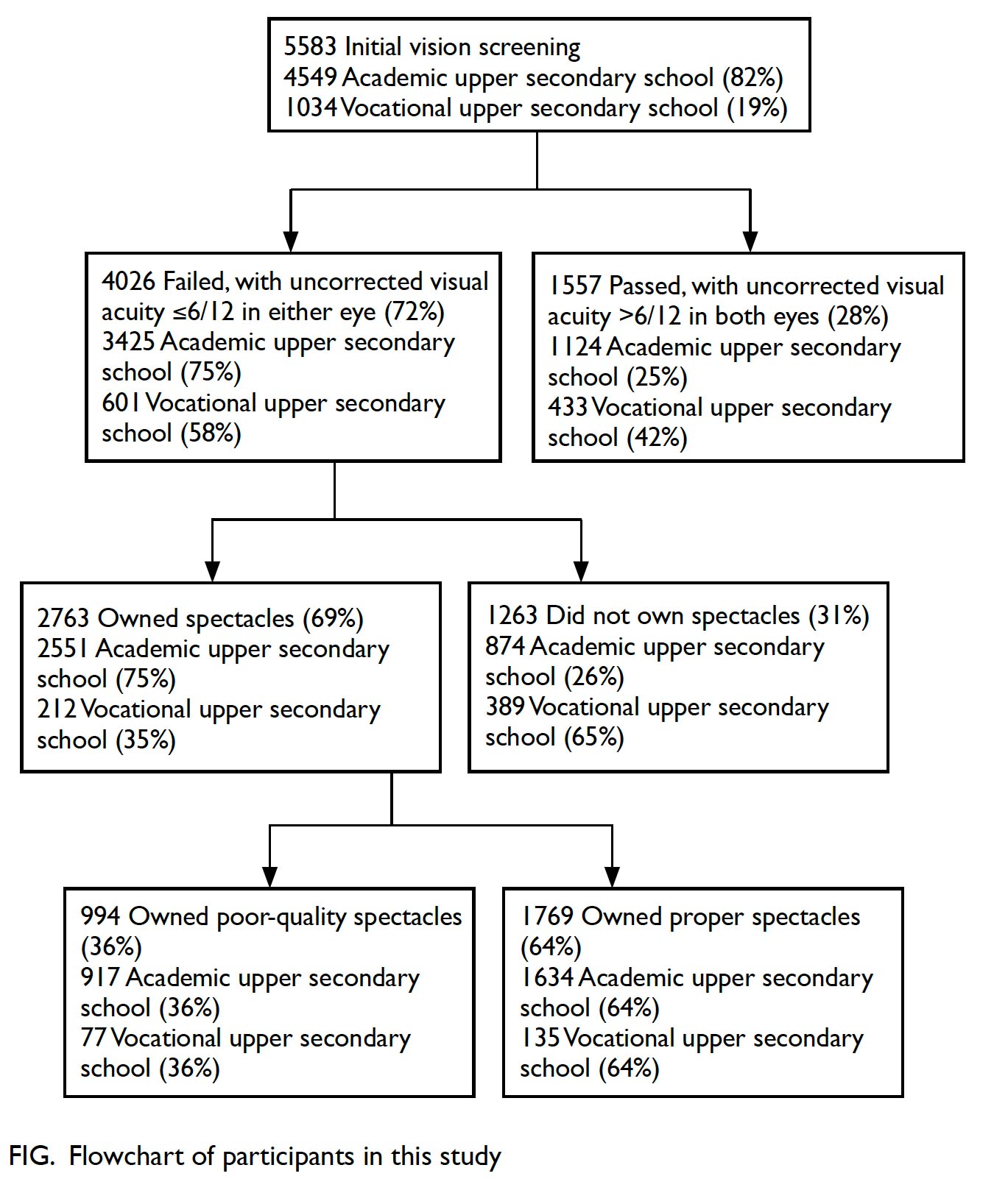Hong Kong Med J 2020 Feb;26(1):35–43 | Epub 6 Feb 2020
© Hong Kong Academy of Medicine. CC BY-NC-ND 4.0
ORIGINAL ARTICLE
Visual impairment and spectacles ownership among upper secondary school students in northwestern China
J Zhao, PhD1; H Guan, PhD1; K Du, PhD1; H Wang, PhD2; Matthew Boswell,MA2; Y Shi, PhD1; Scott Rozelle,PhD2; Nathan Congdon, MD3,4,5; Annie Osborn, BA1
1 Center for Experimental Economics in Education, Shaanxi Normal University, Xi'an, China
2 Freeman Spogli Institute for International Studies, Stanford University, Stanford, California, United States
3 Centre for Public Health, Queen’s University Belfast, Belfast, United Kingdom
4 Orbis International, New York, United States
5 Zhongshan Ophthalmic Center, Guangzhou, China
Corresponding author: Dr H Guan (hongyuguan0621@gmail.com)
Abstract
Purpose: To assess the prevalence of visual impairment and spectacles ownership among academic and vocational upper secondary school students in rural China.
Methods: This cross-sectional study included 5583 students from four academic upper secondary schools (AUSSs) and two vocational upper secondary schools (VUSSs) in Mei and Qianyang counties, Baoji Prefecture, Shaanxi Province. In March and April 2016, students underwent assessment of visual acuity (VA) and completed a questionnaire regarding spectacles use and family characteristics. Students with visual impairment (presenting VA ≤6/12 in the better eye) and students needing spectacles (uncorrected VA ≤6/12 in the better eye, which could be improved to >6/12 with refraction) were identified.
Results: Among 5583 students (54% boys, mean age 16.4±1.0 years) in grades 10 and grade 11 attending AUSSs (n=4549) and VUSSs (n=1034), visual impairment was detected in 4026 students. Among the AUSS students, 3425 (75%) needed spectacles; 2551 (75%) had them. Among the VUSS students, 601 (58%) needed spectacles; this proportion was significantly smaller (P=0.004), as was the proportion who had spectacles (n=212, 35%, P<0.001), compared with the AUSS students. Multivariate analysis showed that ownership of spectacles among children who needed them was associated with worse uncorrected VA (P<0.001), male sex (P<0.001), and residence in an urban area (P<0.034). Spectacles ownership was also strongly associated with AUSS education (P<0.001).
Conclusion: There is a high rate of unmet need in visual care among upper secondary school students. Lack of spectacles ownership among children who needed them was significantly associated with VUSS education.
New knowledge added by this study
- This study investigated the prevalence of refractive error and rate of spectacles ownership among 5583 students in academic upper secondary schools (AUSSs) and vocational upper secondary schools (VUSSs) in northwestern rural China.
- Visual impairment was observed in 4026 students, of whom 3425 were in AUSSs (75%) and 601 were in VUSSs (58%). Of these 4026 students, 2763 were observed to own spectacles. Among the 2763 students who owned spectacles, 2551 of those were in AUSSs (75%) and 212 were VUSSs (35%).
- Among students who needed spectacles, a larger proportion of students in VUSSs did not own spectacles, compared with students in AUSSs.
- There is a high rate of unmet need in visual care among upper secondary school students in rural northwestern China.
- China’s health and education policymakers should consider incorporating programmes that specifically address spectacles ownership and quality among rural upper secondary schools, especially among those attending vocational upper secondary schools and those with low socio-economic status.
Introduction
Half of all children with vision problems worldwide reside in China,1 and many children in rural China are visually impaired. In particular, a recent study of vision problems among primary school children in rural northwestern China showed that 24% of 9- to 11-year-old students in grades 4 and 5 of primary school had myopia.2 Among 13- to 15-year-old students in lower secondary school, half (50.4%) of all students reportedly exhibit visual impairment.3 Other studies have shown similarly high rates of myopia among children in rural China.4 5
Children with poor vision experience academic difficulty, such that poor vision is significantly negatively correlated with academic performance.2 Appropriate spectacles wear has been shown to increase the capacity and motivation of students to learn. In two recent randomised controlled trials in China, students who were provided free spectacles demonstrated statistically significant improvement in academic performance.3 5 Although spectacles enable non-invasive, inexpensive treatment of myopia, a significant proportion of rural Chinese children who need spectacles do not own them.6 In a sample of 18 915 students in grades 4 to 6 in rural Gansu Province, >97% of near-sighted students did not own spectacles.7 Among 9- to 11-year-old students in primary school, as few as one in six students with poor uncorrected vision owned spectacles.2 In lower secondary school, only 37% of students who needed spectacles were observed to own spectacles.
In addition to the outright failure to own spectacles, under-correction or the use of poorly fitted spectacles (including spectacles with refractive inaccuracy and spectacles that were not upgraded in a timely manner) may increase the burden of children with poor vision due to refractive error.6 Researchers have discovered high rates of inaccuracy in spectacles prescriptions in rural China. In a random sample of 3226 children in 15 middle schools (grades 7-10) in Guangdong Province, nearly 67% of student-owned spectacles were inaccurate. A spectacles quality-check study conducted in 33 primary schools in Shaanxi and 36 primary schools in Gansu showed that nearly half (46%) of students with spectacles had a Snellen visual acuity (VA) that was not corrected to ≥6/12.8 9
An understanding of vision problems among rural students in elementary and lower secondary schools is beginning to emerge in the literature; however, to the best of our knowledge, few studies have examined visual impairment and spectacles ownership among the approximately 13.5 million upper secondary school (grades 10-12) students in rural China. Empirical studies regarding spectacles quality among these students are similarly scarce. As a result, factors determining spectacles ownership and quality at this age are poorly understood. Vision problems among upper secondary school students are of particular concern in rural China because visual impairment has been shown to increase as students age through the school system; notably lower secondary school students experience higher rates of impairment and uncorrected poor vision, compared with primary school students.10 Therefore, there may be a greater need for quality vision care among upper secondary school students.
Furthermore, these vision problems among students in rural China are of particular concern because of China’s two-track upper secondary school system. Specifically, there are two types of upper secondary schools, academic upper secondary schools (AUSSs) and vocational upper secondary schools (VUSSs). Empirical studies comparing AUSS and VUSS students in China have shown that VUSS attendance does not lead to gains in specific skills and that it reduces general skills (relative to AUSS attendance). Moreover, VUSS students have a higher tendency to drop out.11 The primary determinant of whether a student attends an AUSS or a VUSS is that student’s performance on an entrance exam. Given that uncorrected vision in primary and middle school can lead to reduced academic performance,3 7 students without spectacles or with incorrect prescriptions may be attending VUSSs at higher rates than are consistent with their abilities. There may also exist a feedback mechanism between the skills VUSS students are likely to learn and the rates of spectacles ownership, as well as the quality of spectacles, among these students. In particular, high rates of uncorrected refractive error could mean that VUSS students experience smaller benefits from school than AUSS students; this might cause students (or their parents) to have less interest in spectacles. However, without empirical studies to assess potential links between spectacles ownership and quality in both AUSS and VUSS, there is no basis to study causal mechanisms. Understanding differences in vision and access to quality vision care in China’s upper secondary school environment can help to support future studies of this issue.
The overall objective of this study was to assess the prevalence of visual impairment, rate of spectacles ownership, and quality of spectacles among upper secondary school students in northwestern rural China. To fulfil this objective, there were three specific aims. First, the prevalence of refractive error, rate of spectacles ownership, and quality of spectacles were assessed in both AUSS and VUSS students. Second, the factors associated with spectacles ownership were assessed among students who had refractive errors. Finally, the association between spectacles ownership and type of upper secondary school (AUSS or VUSS) was investigated.
Methods
The protocol for this study was approved in full by Institutional Review Boards at Stanford University, Palo Alto, US, and the Zhongshan Ophthalmic Center, Guangzhou, China. Permission was received from the local Board of Education in each county, as well as the principals of all schools involved. The principles of the Declaration of Helsinki were followed throughout.
Setting
This study was carried out in Mei and Qianyang counties, both of which are located within Baoji prefecture in the southern part of Shaanxi Province. The Shaanxi Province per capita gross domestic product (GDP) was $7728 in 2015.12 Baoji prefecture ranked approximately in the middle of all prefectures within Shaanxi Province (ranked 4/10 at $7651 per year).13 The per capita GDP in Baoji prefecture is similar to the per capita GDP in Shaanxi Province. In terms of per capita GDP, Mei county and Qianyang county ranked approximately in the middle of all counties in Shaanxi Province (Mei county ranked 44/107 at $5667 per year, while Qianyang county ranked 55/107 at $5272 per year)13; therefore, the per capita GDPs of these two counties are relatively similar to the per capita GDP of Shaanxi Province ($7728). The per capita GDPs in these two counties are similar to the per capita GDPs in Ningxia Autonomous Region ($6210) and Qinghai Province ($5845).14 In addition to its average GDP, our sample area is broadly representative of poorer rural parts of northwestern China due to the scarcity of agricultural resources (cultivated land per capita of only 0.11 hectares per household, similar to the regional average).12
Data collection
Data for this study were collected in Mei county during March 2016, and in Qianyang county during April 2016. The study was conducted at all six upper secondary schools in Mei and Qianyang counties, including four AUSSs (3 in Mei county and 1 in Qianyang county) and two VUSSs (1 in each county). Total enrolment for the six schools was 5583 students; 4549 attended AUSSs and 1034 attended VUSSs. Access to these schools for research purposes was granted by the Board of Education of each county. All students in all grades 10 and 11 in each sample county and sample school participated in the data collection process.
Data were collected in two parts by enumerators, graduate students from Shaanxi Normal University who had been trained by optometrist from the Zhongshan Ophthalmic Center. In the first part of the data collection effort, enumerators administered a questionnaire to all students, regarding a number of student and household characteristics. The variables that were created from the data included spectacles ownership (defined as the ability to produce spectacles at school on the day the questionnaire was administered, following prior instructions to bring them that day), grade level, sex, urban or rural residence, school type, boarding status at school, parental migration status (both parents worked away from home this semester), and parental educational level. In the second part of the data collection effort, the survey team conducted a VA test to measure the sharpness of each student’s vision. Visual acuity was measured without refractive correction for all children, as well as with habitually worn correction for children who owned spectacles. The data collection procedure is shown in the Figure.
Visual acuity assessment
The VA assessment was conducted using Early Treatment in Diabetic Retinopathy Study Tumbling-E charts (Precision Vision, La Salle [IL], US). The chart has 14 rows of optotypes (represented by a capital letter E) with five optotypes pointing randomly in different directions in each row. The sizes of the optotypes become smaller with vertical movement downward on the chart. Visual acuity is recorded as 6/X, such that X varies between 60 (at the top of the chart) and 3 (at the bottom of the chart) when tested at a distance of 4 m.
The VA was measured without refractive correction for all children, as well as with habitually worn correction for children who owned spectacles. Each eye was tested separately in a well-lit, indoor area of each school. Students stood at a distance of 4 m from a Tumbling-E chart. Each student began testing from the top row (6/60). If the orientation of at least four of the five optotypes was correctly identified, the student was examined on row 4 (6/30). Failure was defined as an inability to correctly identify the orientation of at least four of the five optotypes in a given row. If one or fewer optotypes was missed on row 4, the testing resumed at row 7 (6/15) and continued to row 11 (6/6). If a student failed, the row immediately above the failed row was tested until the student identified at least four of the five optotypes in a row. The lowest row read successfully was recorded as the VA for the eye undergoing testing. If the top row was missed at 4 m, the student was progressively advanced to 1 m with progression down the chart as described above, and the VA was divided by 4. In this study, we defined normal vision as VA >6/12 in both eyes, in accordance with published definitions.4 Thus, a failed visual screening was defined as uncorrected VA ≤6/12 in either eye.
We also performed a subgroup analysis of students with poor vision, which was defined as uncorrected VA ≤6/12 in the better eye. The definition of visual impairment in the better eye included only binocular visual impairment. Using the VA of the better eye as a cut-off for poor vision is a common practice in clinical vision research, because the VA of the better-seeing eye is the best indication of an individual’s level of vision.4 6 15 We stratified poor vision into mild poor vision (presenting VA ≤6/12 to 6/18), moderate poor vision (presenting VA <6/18 to 6/60), and severe poor vision (presenting VA <6/60), in accordance with categories proposed in the World Health Organization International Statistical Classification of Disease 10th Revision.2
To calculate and compare different VA levels in this study, we used a linear scale with constant increments, logMAR (logarithm of the minimum angle of resolution).2 logMAR is one of the most commonly used continuous scales to describe VA, and uses the logarithm transformation: logMAR = log10 (1/VA). logMAR offers a relatively intuitive interpretation of VA measurement. Its scale uses constant increments of 0.1, where each increment indicates approximately one line of VA loss in the Early Treatment in Diabetic Retinopathy Study chart. Higher logMAR values indicate worse VA.2
Statistical methods
We first conducted a general descriptive analysis of visual impairment, spectacles ownership, and spectacles quality. We also investigated the prevalence of various baseline variables among students attending AUSSs and those attending VUSSs. Variables included logMAR VA, level of poor vision (ie, mild, moderate, or severe), school type (AUSS=1), age, grade (grade 10=1), sex (male=1), boarding status (living at school=1), residence (urban=1), parental migration status (both migrated=1), and parental education for both mother and father (completed ≥12 years of education=1).
Next, to explore potential factors influencing spectacles ownership, we investigated all baseline variables as predictors of ownership among students who needed spectacles, using simple and multiple logistic regression analyses. We included only students with uncorrected VA ≤6/12 in either eye in our regression analyses. To explore the relationship between spectacles ownership and the type of upper secondary school (AUSS or VUSS), we employed a second logistic regression analysis method, which controlled for VA, age, sex, urban or rural residence, parental migration status, and parental education levels; this analysis included only students with uncorrected VA ≤6/12 in either eye. All analyses were performed using Stata version 14.0 statistical software (StataCorp, College Station [TX], US). All tests were two-sided and P<0.05 was considered statistically significant.
Results
Among the 5583 students (54% boys, mean age 16.4±1.0 years) in grades 10 and grade 11 at four AUSSs (n=4549) and two VUSSs (n=1034), 100% completed both the questionnaire and the vision screening. Uncorrected VA of ≤6/12 was present in 4026 students (72%); of these, 3425 were in AUSSs (75% of AUSS students) and 601 were in VUSSs (58% of VUSS students). A greater proportion of AUSS students had poor vision, compared with VUSS students (P=0.004, Table 1).
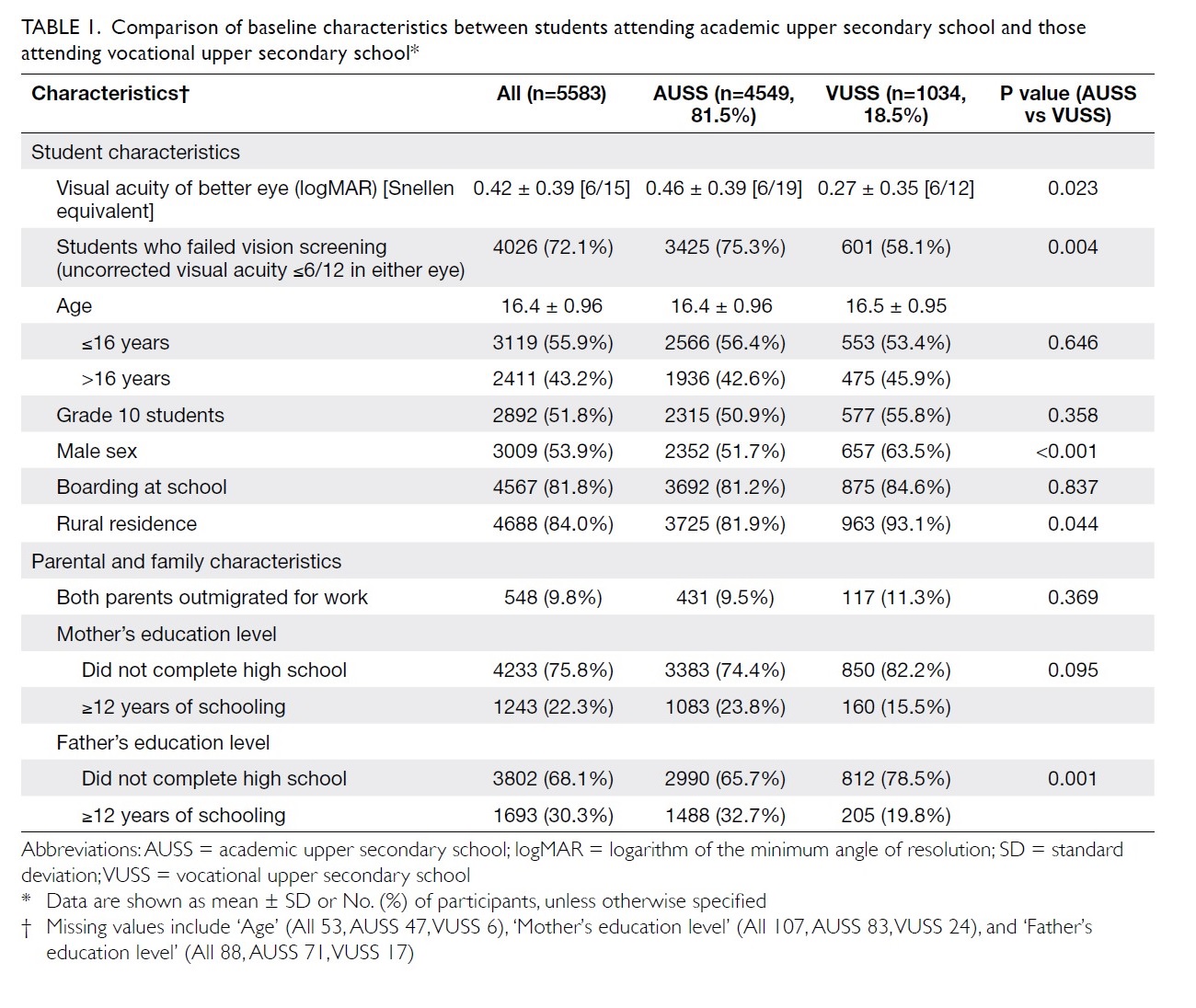
Table 1. Comparison of baseline characteristics between students attending academic upper secondary school and those attending vocational upper secondary school
Among students with poor uncorrected vision, 2763 (69%) demonstrated owning spectacles. Of the students who owned spectacles, 2551 were in AUSSs (75% of students with poor vision attending AUSSs) and 212 were in VUSSs (35% of students with poor vision attending VUSSs). Among students who needed spectacles, a greater proportion of students in VUSSs did not own spectacles, compared with students in AUSSs (Table 2).
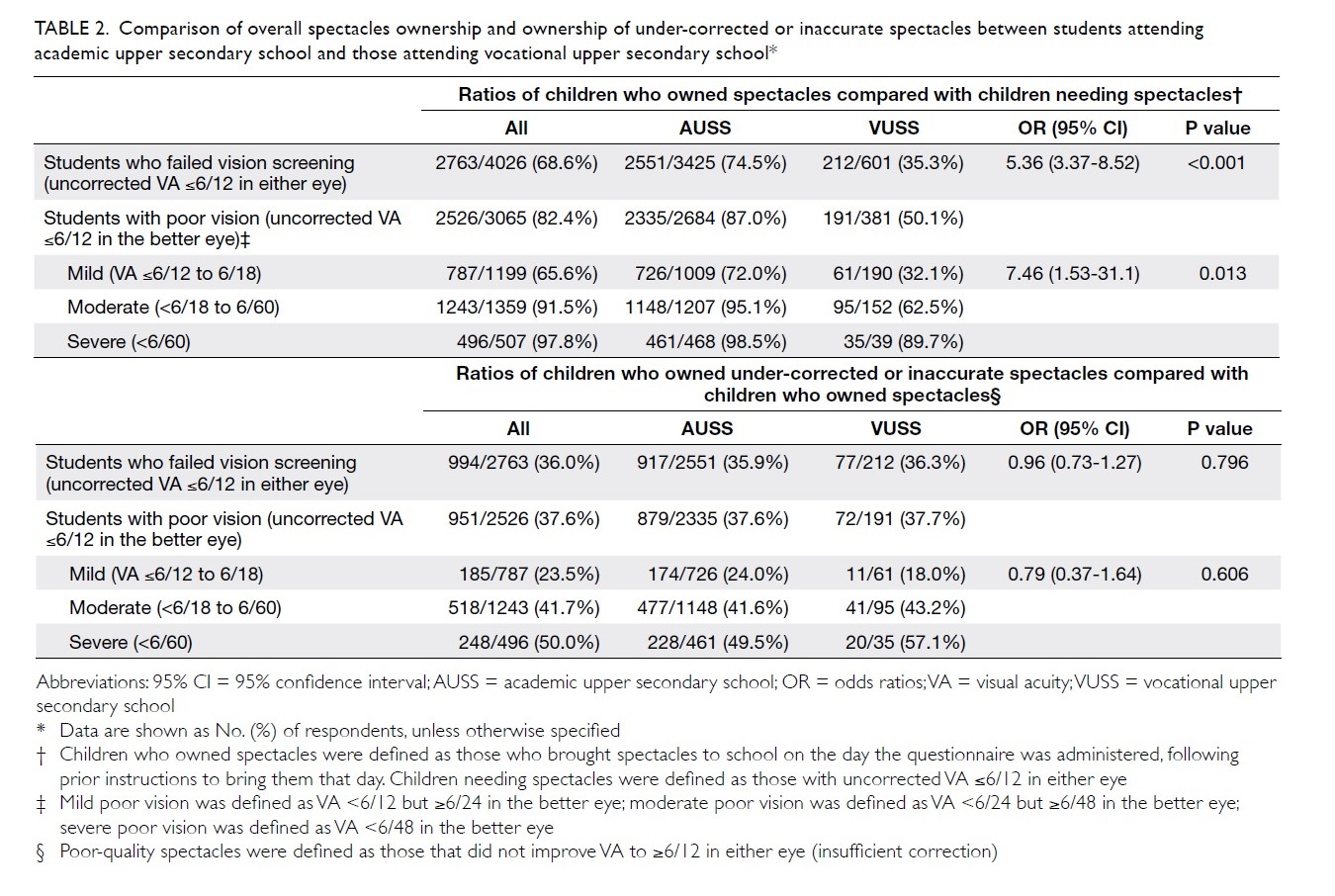
Table 2. Comparison of overall spectacles ownership and ownership of under-corrected or inaccurate spectacles between students attending academic upper secondary school and those attending vocational upper secondary school
When spectacles ownership was stratified by severity of visual impairment in the better eye, 72% of students with mild poor vision (726/1009) in AUSSs and 32% of students with mild poor vision (61/190) in VUSSs had spectacles. Of students with moderate poor vision, 95% (1148/1207) in AUSSs and 63% (95/152) in VUSSs had spectacles. Finally, of students with severe poor vision, 99% (461/468) in AUSSs and 90% (35/39) in VUSSs had spectacles (Table 2). The spectacles owned by the students were often under-corrected or exhibited refractive inaccuracy; 36% of students who had spectacles failed the VA screening while wearing their spectacles. Both AUSS and VUSS students who had spectacles were equally likely to have under-corrected vision (Table 2).
Simple logistic regression models for predicting spectacles ownership revealed that the following characteristics were significant predictors among students with poor vision (Table 3): worse uncorrected VA (P<0.001); AUSS attendance (P<0.001); a lower grade level (P=0.006); male sex (P<0.001); boarding at school (P=0.001); residence in an urban area (P=0.001); and both parents out-migrated for work (P=0.015). Students whose mothers had completed at least 12 years of education were also more likely to own spectacles than students whose mothers did not finish upper secondary school (P=0.006); similarly, students whose fathers completed at least 12 years of education were more likely to own spectacles (P=0.020).
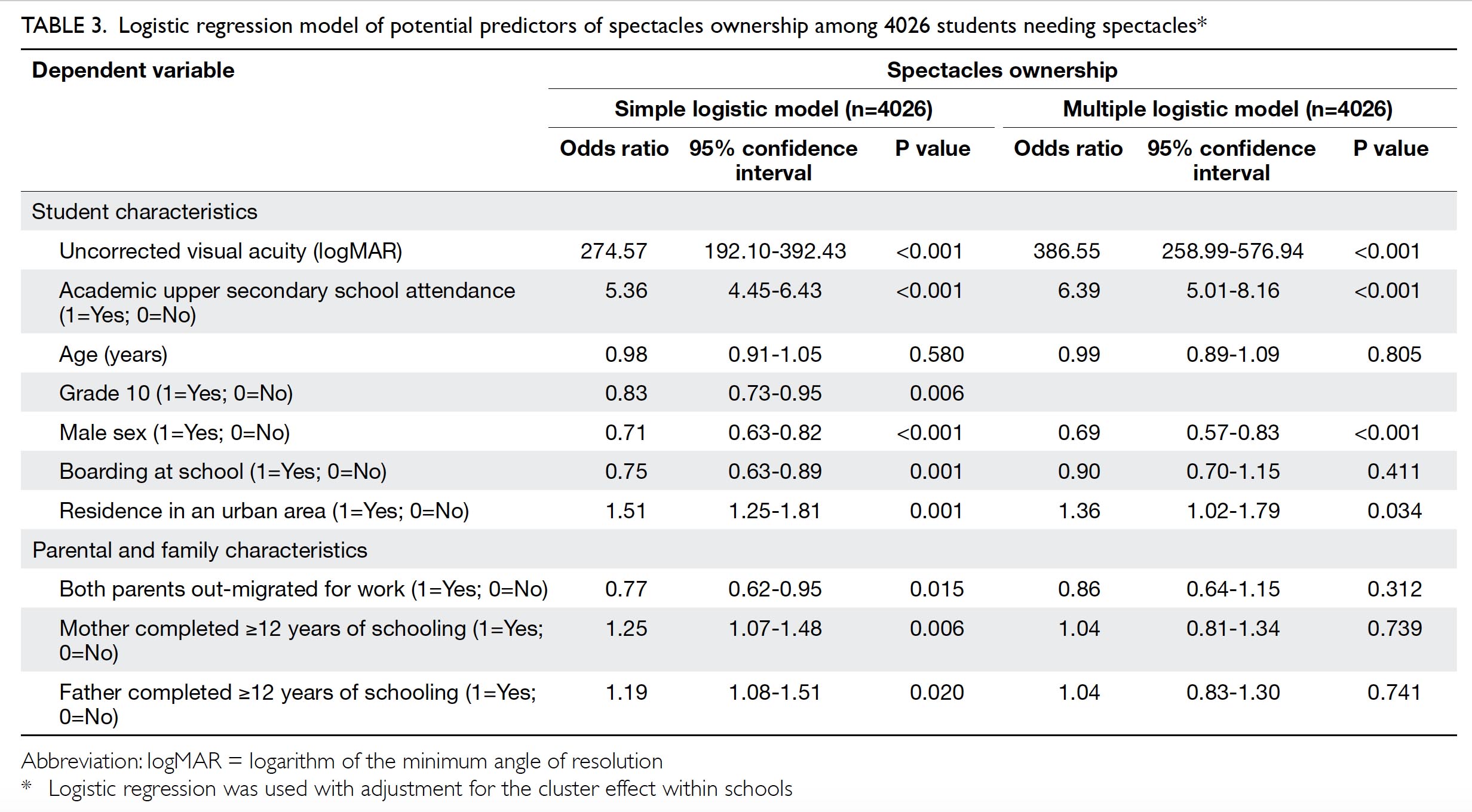
Table 3. Logistic regression model of potential predictors of spectacles ownership among 4026 students needing spectacles
Multiple logistic regression analysis revealed that the following characteristics were associated with spectacles ownership: worse uncorrected VA (P<0.001); AUSS attendance (P<0.001); male sex (P<0.001); and residence in an urban area (P=0.034). In this model, age, boarding status, parental out-migration, and education status were not associated with spectacles ownership (Table 3). In the multiple logistic regression model investigating the relationship between spectacles ownership and type of upper secondary school, spectacles wear was strongly associated with AUSS attendance (P<0.001); the same result was obtained when controlling for student characteristics and parental characteristics (Table 4).
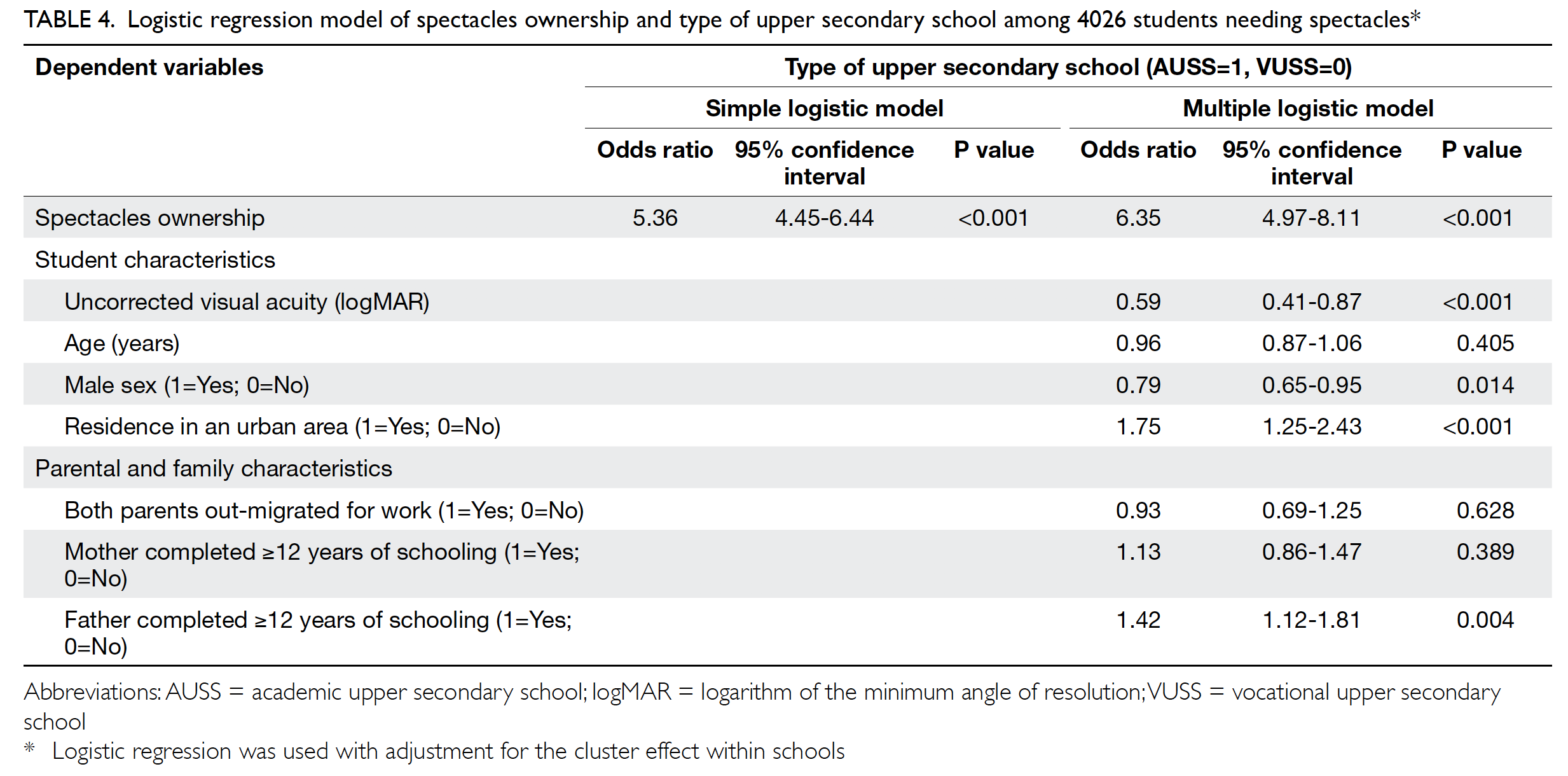
Table 4. Logistic regression model of spectacles ownership and type of upper secondary school among 4026 students needing spectacles
Discussion
Our study found a high prevalence of poor vision among upper secondary school students in rural northwestern China: nearly 72% of these students had refractive errors, which was consistent with the results of a prior analysis in which a high prevalence of poor vision was found among upper secondary school students in rural areas.15 Furthermore, rates of correction were well below poor vision prevalence rates: overall, 31% of students who needed spectacles were not wearing them in this rural northwestern Chinese cohort.
Furthermore, nearly 40% of the students who wore spectacles had prescriptions with under-correction or refractive inaccuracy. Thus, nearly half of students with poor vision and more than one third of all students are attending school without clear vision. This demonstrates a high rate of unmet need in visual care among upper secondary school students, which is consistent with the findings of studies from primary and lower secondary schools in rural northwestern China.2 6 16
Based on our results, we suspect that several factors may contribute to the low rates of spectacles ownership among rural upper secondary school students. In particular, rates of spectacles ownership were higher in students with worse uncorrected VA, which suggests that students with mild poor vision do not experience a need to correct their vision; these students or their parents may mistakenly presume that spectacles are unnecessary or associated with deteriorations in eyesight.17
Another factor that may affect spectacles ownership is a family’s level of income/wealth. Spectacles ownership rates were higher among students residing in urban areas, as well as among students with better-educated fathers. These factors may act as proxies for family wealth18 19; thus, our results suggest that children in a wealthier family are more likely to wear spectacles when needed. Rural students tend to be much poorer than their urban counterparts, which may explain why many do not own spectacles. Our findings are consistent with those found in the literature.2 9
Our results also showed that spectacles ownership was strongly associated with AUSS attendance. This finding implies involvement of several factors in spectacles ownership. One of these factors may be the expectations of academic performance for VUSS students, who have lower rates of spectacles ownership than their AUSS peers; VUSS students may have a lighter academic burden,20 which allows them to tolerate poorer vision. Their parents may also presume that they do not need spectacles. Moreover, the number of VUSS students with poor vision may also contribute to lowered academic achievements and expectations. Our results are only correlative, but future studies of causal mechanisms are needed. Furthermore, given that VUSS graduates have poorer general skills compared with AUSS graduates,20 VUSS students comprise an at-risk population that urgently requires additional investigation.
The overall implication of the study, similar to the findings in studies of primary school and lower secondary school,2 3 5 is that systematic implementation of vision care programmes is needed in rural Chinese schools, including upper secondary schools. There is a need to more clearly identify which students exhibit poor vision, as well as a need for programmes that provide spectacles or encourage spectacles wear among affected students. Finally, there is a need for programmes that provide high-quality spectacles.
This study was limited in three ways. First, the results were based on cross-sectional data, such that it was difficult to perform a causal analysis between spectacles ownership and upper secondary school educational choice. Second, data regarding school performance and spectacles ownership were not collected when students were in lower secondary school (prior to AUSS or VUSS attendance); these data might have been useful in a causal analysis. Therefore, we cannot exclude the possibility that factors specific to AUSSs (for instance, more homework leading to less time spent outdoors) might place AUSS students at greater risk of visual impairment. Furthermore, we cannot exclude the possibility that inability to afford spectacles and the lack of spectacles use prior to taking the entrance exam would result in lower overall learning, which would partially contribute to the type of upper secondary school attended; this contribution may lead to a positive correlation between VUSS attendance and poor vision. Third, the participants in this study were recruited from two counties in rural northwestern China, which limits the external validity of the findings.
Despite these limitations, we believe the results from this study provide compelling evidence that a number of students in rural northwestern China are not receiving adequate vision care: poorer students whose parents have less education are less likely to have spectacles when needed; VUSS students are also less likely to have spectacles when needed, compared with AUSS students. We presume that these findings will aid programme planners in targeting vulnerable populations when formulating strategies to reduce the burden of uncorrected myopia in rural China. China’s health and education policymakers should consider incorporating programmes that specifically address spectacles ownership and quality in rural upper secondary schools, especially among VUSS students and poorer students.
Author contributions
All authors contributed to the study, approved the final version for publication, and take responsibility for its accuracy and integrity.
Concept or design: All authors.
Acquisition of data: J Zhao, H Guan, K Du, Y Shi.
Analysis or interpretation of data: J Zhao, H Guan, K Du, Y Shi.
Drafting of the article: J Zhao, H Guan, H Wang, M Boswell, AOsborn.
Critical revision for important intellectual content: H Wang, M Boswell, S Rozelle, N Congdon.
Acquisition of data: J Zhao, H Guan, K Du, Y Shi.
Analysis or interpretation of data: J Zhao, H Guan, K Du, Y Shi.
Drafting of the article: J Zhao, H Guan, H Wang, M Boswell, AOsborn.
Critical revision for important intellectual content: H Wang, M Boswell, S Rozelle, N Congdon.
Conflicts of interest
All authors have disclosed no conflicts of interest.
Funding/support
This study was supported by the 111 Project (Grant No. B16031). H Guan is funded by the National Natural Science Foundation of China, grant number 7180310.
Ethics approval
This study was approved by the institutional review board at Stanford University, Palo Alto, United States (Ref 52514). Permission was received from local boards of education in each region and the principals of all schools. A letter was given to children and the parents informing them of the vision screening of their child, and a receipt returned to the school to show the parent consent. The presented data are anonymised, and the risk of identification is low. This study was performed in accordance with the principles of the Declaration of Helsinki.
References
1. Resnikoff S, Pasolini D, Mariotti SP, Pokharel GP. Global magnitude of visual impairment caused by uncorrected refractive errors in 2004. Bull World Health Organ 2008;86:63-70. Crossref
2. Yi H, Zhang L, Ma X, et al. Poor vision among China's rural primary school students: prevalence, correlates and consequences. China Econ Rev 2015;33:247-62. Crossref
3. Nie J, Pang X, Sylvia S, Wang L, Rozelle S. Seeing is believing: experimental evidence on the impact of eyeglasses on academic performance, aspirations and dropout among junior high school students in rural China. Econ Dev Cult Change 2018. Available from: https://www. journals.uchicago.edu/doi/10.1086/700631. Accessed 12 Dec 2019.
4. He M, Zeng J, Liu Y, Xu J, Pokharel GP, Ellwein LB. Refractive error and visual impairment in urban children in Southern China. Invest Ophthalmol Vis Sci 2004;45:793-9. Crossref
5. Ma X, Zhou Z, Yi H, et al. Effect of providing free glasses on children's educational outcomes in China: cluster randomized controlled trial. BMJ 2014;349:g5740. Crossref
6. Congdon N, Wang Y, Song Y, et al. Visual disability, visual function, and myopia among rural Chinese secondary school children: the Xichang Pediatric Refractive Error Study (X-PRES)-Report 1. Invest Ophthalmol Vis Sci 2008;49:2888-94. Crossref
7. Glewwe P, Park A, Zhao M. A better vision for development: eyeglasses and academic performance in rural primary schools in China. J Dev Econ 2016;122:170-82. Crossref
8. Zhang M, Lv H, Gao Y, et al. Visual morbidity due to inaccurate spectacles among school children in rural China: the See Well to Learn Well Project, report 1. Invest Ophthalmol Vis Sci 2009;50:2011-7. Crossref
9. Zhou Z, Zeng J, Ma X, et al. Accuracy of rural refractionists in western China. Invest Ophthalmol Vis Sci 2014;55:154-61. Crossref
10. Ma Y, Congdon N, Shi Y, et al. Effect of a local vision care center on eyeglasses use and school performance in rural China: a cluster randomized clinical trial. JAMA Ophthalmol 2018;136:731-7. Crossref
11. Yi H, Li G, Li L, et al. Assessing the quality of upper- secondary vocational education and training: evidence from China. Comp Educ Rev 2018;62:199-230. Crossref
12. China Statistics Press. Shaanxi Statistical Yearbook 2015. Available from: http://www.shaanxitj.gov.cn/upload/2016/tongjinianj/2015/indexch.htm. Accessed 20 Jan 2016.
13. Baoji Statistical Yearbook 2015. Available from: http://tjj. baoji.gov.cn/plus/list.php?tid=32&TotalResult=135&Page
No=3 . Accessed 22 Sep 2017.
14. National Bureau of Statistics, PRC government. China Statistical Yearbook 2015. Available from: http://data.stats.
gov.cn/easyquery.htm?cn=E0103. Accessed 9 Jan 2017.
15. He M, Huang W, Zheng Y, Huang L, Ellwein LB. Refractive error and visual impairment in school children in rural
southern China. Ophthalmology 2007;114:374-82.
16. Wang X, Yi H, Lu L, et al. Population prevalence of need for spectacles and spectacle ownership among urban migrant children in eastern China. JAMA Ophthalmol
2015;133:1399-406. Crossref
17. Sharma A, Congdon N, Patel M, Gilbert C. School-based approaches to the correction of refractive error in children.
Surv Ophthalmol 2012;57:272-83.
18. Sutherland D, Yao S. Income inequality in China over 30 years of reforms. Camb J Reg Econ Soc 2011;4:91-105. Crossref
19. Eccles JS. Influences of parents’ education on their children’s educational attainments: the role of parent and
child perceptions. Lond Rev Educ 2005;3:191-204. Crossref
20. Loyalka PK, Huang X, Zhang L, et al. The impact of vocational schooling on human capital development in developing countries: evidence from China. World
Bank Econ Rev 2016;30:143-70. Crossref


